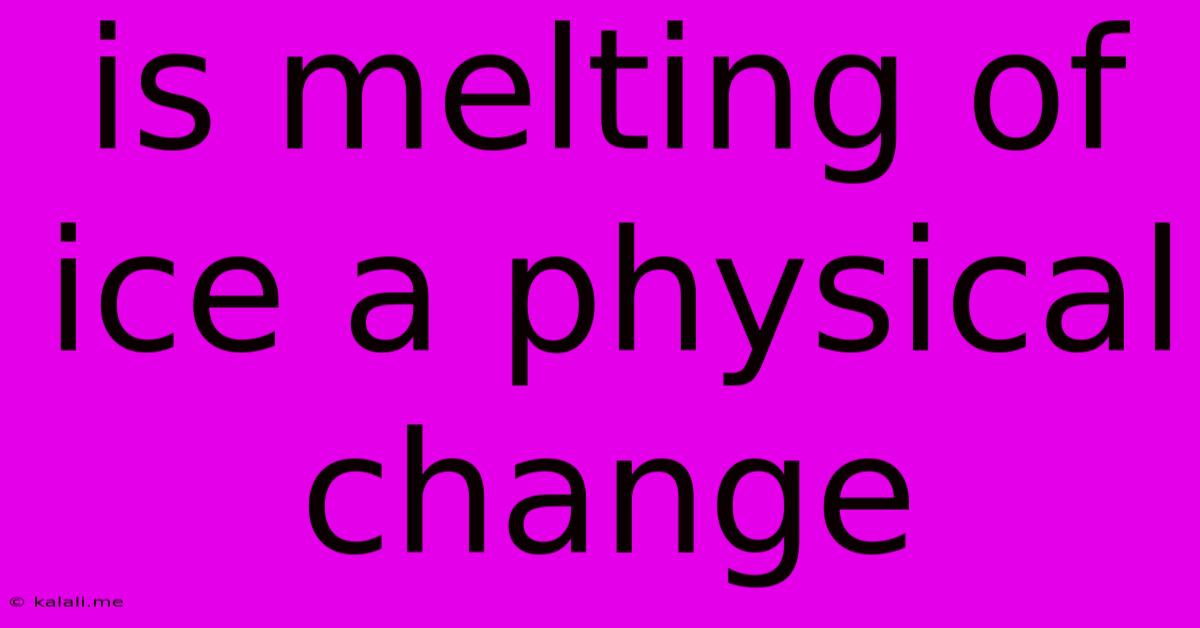Is Melting Of Ice A Physical Change
Kalali
May 10, 2025 · 3 min read

Table of Contents
Is Melting Ice a Physical Change? A Comprehensive Look
Is melting ice a physical change or a chemical change? This seemingly simple question leads to a deeper understanding of matter and its transformations. The short answer is yes, melting ice is a physical change. This article will explore why, examining the differences between physical and chemical changes and providing clear examples to solidify your understanding.
Melting ice involves a change in the state of matter from solid (ice) to liquid (water), but the chemical composition remains the same. It's crucial to remember this key distinction when classifying changes. This meta description should help people understand what the article is about before they click.
Understanding Physical Changes
A physical change alters the form or appearance of a substance but doesn't change its chemical composition. Think of it like rearranging furniture in a room – the furniture (molecules) is the same, but its arrangement is different. Examples of physical changes include:
- Changes in state: Melting, freezing, boiling, condensation, and sublimation (solid to gas).
- Changes in shape: Cutting, bending, breaking, and grinding.
- Dissolving: Salt dissolving in water. (While dissolved, the salt retains its chemical identity and can be recovered.)
These changes are usually reversible. You can freeze liquid water back into ice, for example.
Understanding Chemical Changes
In contrast, a chemical change, also known as a chemical reaction, results in the formation of new substances with different chemical properties. The original substances are transformed into entirely new ones. Think of baking a cake – you can't reverse the process to get back the individual ingredients. Examples include:
- Burning: Wood burning into ash and smoke.
- Rusting: Iron reacting with oxygen to form iron oxide (rust).
- Cooking: Eggs changing from liquid to solid when cooked.
These changes are often irreversible, or require significant energy input to reverse.
Why Melting Ice is a Physical Change
When ice melts, the water molecules that make up the ice are still water molecules. The only change is their arrangement. In ice, the molecules are held tightly together in a rigid structure. As heat is added, the molecules gain energy, breaking the bonds holding them in place, allowing them to move more freely and become liquid water. No new substance is created; it's simply a change in state.
Key Characteristics Supporting Physical Change:
- Reversible: Liquid water can be easily frozen back into ice.
- No new substance formed: The chemical composition (H₂O) remains the same.
- Change in state only: The transformation is solely from solid to liquid.
- Relatively easy to reverse: The process requires minimal energy.
Other Phase Changes and Physical Changes
It's important to note that other phase transitions of water, such as freezing, boiling, and condensation, are also examples of physical changes. These changes only alter the state of the water, not its chemical makeup.
In conclusion, the melting of ice is unequivocally a physical change. It demonstrates a clear transition between states of matter without altering the inherent chemical composition of the substance. Understanding the distinction between physical and chemical changes is fundamental to comprehending the behavior of matter and its transformations.
Latest Posts
Latest Posts
-
What Is The Average Iq For A 9 Year Old
Jul 13, 2025
-
How Long Does It Take For Brandy Melville To Ship
Jul 13, 2025
-
How Many Times Does 3 Go Into 30
Jul 13, 2025
-
In What Episode Of Bleach Does Ichigo Ask Orihime Out
Jul 13, 2025
-
How Much Is 4 Oz Chocolate Chips
Jul 13, 2025
Related Post
Thank you for visiting our website which covers about Is Melting Of Ice A Physical Change . We hope the information provided has been useful to you. Feel free to contact us if you have any questions or need further assistance. See you next time and don't miss to bookmark.